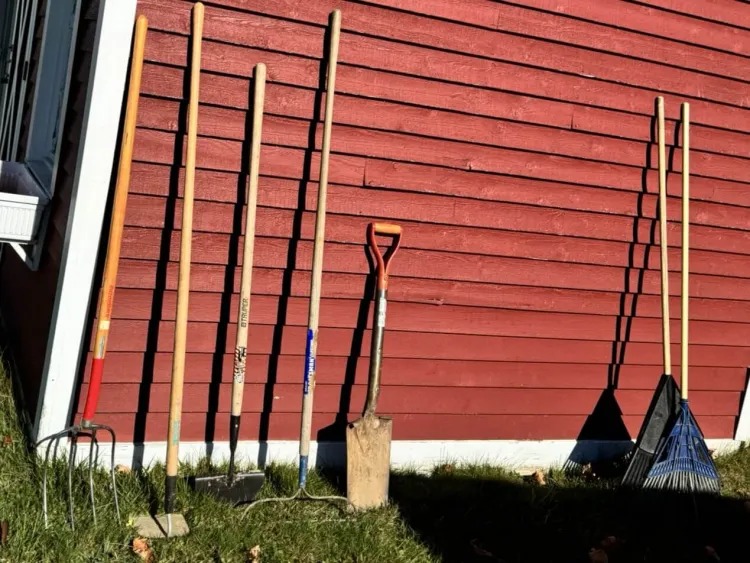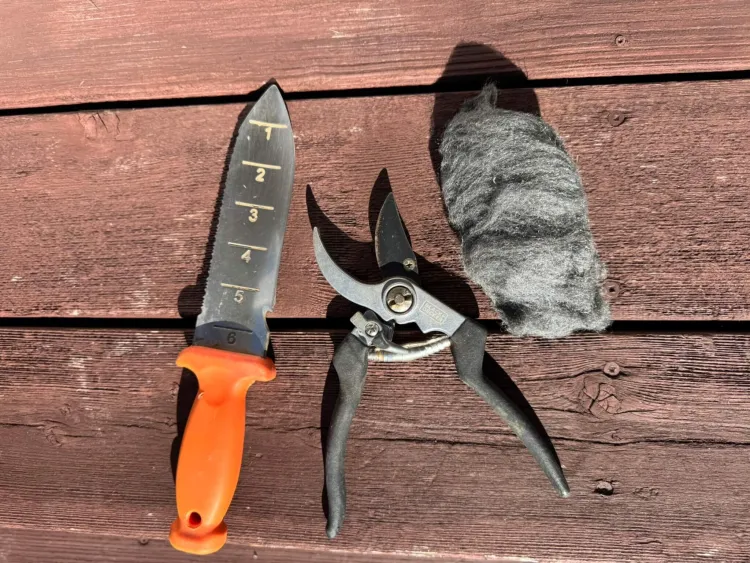Storing garden tools is likely one of the last projects you’ll tackle when putting your garden to bed. You could just stash everything in the garage or garden shed and be done with it until spring. Instead, take the time now to clean, inspect, and make any needed repairs. If you do, they’ll be ready to go to work in your garden when spring arrives.
You can gather everything together and do what’s needed all at the same time or take care of each tool as you finish using it for the season. Whichever way you decide to tackle this task, make sure you have an organized storage space that’s dry and safe from winter weather.

First, clean each item. For most, spraying with water will get the job done. Stubborn, dried-on soil can be removed using a stiff-bristled brush. Use warm water with a bit of dish soap to remove sap residue. Rust spots can be dealt with using steel wool or sandpaper.
Once clean, be sure to dry garden tools thoroughly. Before storing, wipe metal parts on hand tools with mineral oil to help protect from moisture.
While cleaning each garden tool, take the opportunity to inspect it for damage and needed maintenance. Is a blade bent or a screw in need of tightening? A handle loose or cracked? Save yourself from splinters caused by rough wooden handles: smooth the surface with sandpaper then wipe on a light coating of mineral oil.
Bladed tools—pruners, loppers, pruning saws, lawn mowers, and so on—may need sharpening. If you take them to a professional to sharpen, you may find the waiting time shorter this fall than it will be in the spring. You might decide to do so yourself if you’re comfortable and familiar with the process.
Inventory what you have and make note of what you’ll need. That includes not only replacements for garden tools past their useful life, but also parts or accessories that may be needed or help make tasks easier. An extra spool of line for a string trimmer can save time and frustration when you return to the garden next spring. Likewise, a longer extension cord or extra battery could prove handy if needed.

Make a list and keep an eye out for season-ending sales or springtime promotions to add them to your garden tool collection.
When taking care of your other garden tools, don’t forget garden hoses. Clean them as needed. Inspect them for leaks. Drain any water remaining in each hose. Finally, coil and store on a hose rack or place on a flat surface.
Powered garden tools and equipment such as lawn mowers, tillers, and string trimmers should be cared for and stored according to manufacturers’ instructions. If you don’t have an owner’s manual, you can likely find a digital version on the manufacturers’ website.
If you’re utilizing more than one location for storage, make a note where you’re storing each item, particularly if parts may be stored separately. While an unheated garage may be a good place for a string trimmer, its battery and charger should be stored together indoors away from freezing temperatures. Note this on your inventory list, your garden journal, or your calendar so that when you want to use that trimmer, you won’t be searching for its battery.
Once your clean, refreshed garden tools are stored away for the winter, you can relax and make plans for spring’s arrival. Your garden tools will be ready when you are.
If you have questions about gardening, contact the University of Vermont Extension Master Gardeners Helpline at https://go.uvm.edu/gardenhelpline.
